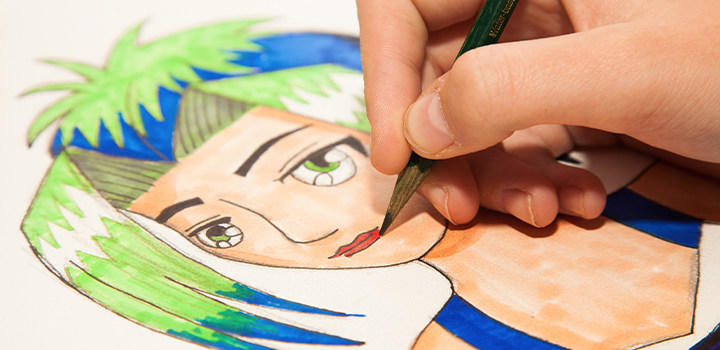
The term “manga” combines under this name all creations relating to Japanese comics. Like comics from North and South America and Europe, manga combines an almost endless array of genres and styles. They draw their inspiration from science fiction, like Katsuhiro Otomo’s cyberpunk dystopia?Akira, from historical fiction like Osamu Tezuka’s?Buddha, or action comedy with superheroes like ONE and?One-Punch Man.?by Yusuke Murata. There are dramas, high school comedies, romantic adventures, horror, and many other genres in the manga. We will show your kids about?House drawing.
Manga Shonen and shoji
In Japan, manga has historically been segmented into gender and age group categories, the two most important being Shonen (for young boys) and shoji (for young girls). The boundaries between these categories have lost their definition in recent years and are generally non-existent outside of Japan.
Visual and narrative convention
Manga uses well-known visual and narrative conventions. A whole generation of fans and young artists took inspiration from these Japanese comics’ style and visual language. A large number of films and series like Avatar, The Last Airbender, Steven Universe, and modern Disney cartoons, like Big Hero Six, show all the influence of manga.
How to start drawing in manga style
Budding manga artists train by reproducing the “comics” or cartoons that inspire them more particularly. “The greatest impression is to support yourself a period of total absence of originality, insists Mark Crilley, author and manga teacher, consider yourself as the apprentice who listens and applies the teaching of a master. Mildred Louis, writer and illustrator, also started out this way. “I started drawing by copying mostly anime manga,” she says, as you learn the techniques, see yourself as the apprentice who listens to and applies a teacher’s teaching. “
Hand used to the pen or pencil.
You will not only sharpen your eye, but you will get your hand used to the pen or pencil. “Your muscles are not yet trained, but a large part of the mastery of drawing relies, in reality, on muscle memory effort,” explains Ethan Young, comic artist. However, be careful; copying has nothing to do with plagiarism. Although the reproduction of a work is essential for your training, could you not pass it off as your work?
Particular proportions of manga style
The anatomical proportions of manga characters make them instantly recognizable. Their eyes tend to be larger than life, but their mouths are smaller. The height of the chin, noses and foreheads is very different from that of a natural human body. The hair often defies gravity, and the facial expressions are nothing like what one would see in art striving for realism. This stylization does not mean that drawing a manga character is simple, however.
Drawing faces for manga
When I started drawing faces for the manga, I went through a two-step process, explains Mr. Crilley, “I thought to myself, this mustn’t be that difficult, it’s very close to the strip. drawn. But from the first attempts, I realized that it was much more complex than that. The facial features require a delicate balance, which requires a lot of attention. As long as you don’t have it, your creations are nothing like manga. The best I can recommend is to practice drawing from a model. “
Draw the actual anatomy
Although it may sound counterintuitive, it takes practice to draw the actual anatomy. “The best I can recommend is to practice drawing from a model,” says Louis, who adds that there are relatively accessible courses available to the public in most cities. It would help if you had a good understanding of the actual proportions to manipulate them before moving on to a much higher styling process.
In the first of three sessions of this video tutorial available life on Bedance, Mark Crilley takes you to step by step through creating a manga-style illustration.
Learn the visual manga language
Comics and cartoons use symbols to express emotions, actions and ideas: in western comics and cartoons, a z line comes out of the mouth of a sleeping character, or when a character has a sudden thought, a light bulb shines above his head.
Type of symbol
Manga also uses this type of symbol. A massive drop of sweat appears on the head of an exasperated or frustrated character. A little snot comes out of a character’s nose to indicate that he is asleep. Lines of movement drawn behind a symbol can mean that he is moving, but also that he is making a dramatic statement, or that he is mainly determined, even to the point of being ridiculous. If a character is embarrassed and ashamed, they will (temporarily) die and become a ghost.
Point of Abstraction
Many of these symbols first appeared as literal representations before being stylized to the point of abstraction. “Previously, the symbol of anger was a very swollen vein, explains Mr. Crilley, it has become an icon representing three or four curved lines. To the uninitiated, it may look like some kind of spark or some kind of star. “
Visual language Important
This visual language also uses different styles of drawing in the same comic. We can draw an aggressive character in a more realistic or detailed style to emphasize their angry temper, while We will draw a joked character in a more cartoonish style. To familiarize yourself with these visual symbols, study popular manga comics, such as Naruto, Case Closed, or Oh My Goddess! Or read the anthology magazine Shonen Jump to learn about the different stylistic approaches to these symbols.
To develop your manga style.
Each famous manga artist has their style. There is a stark contrast between the darkly futuristic illustrations in Yukio Koshiro?s Battle Angel Alita and the comedic adventures in One Piece of Eiichiro Oda. For Ethan Young, you are advancing as an artist means accepting your mistakes. It is by overcoming the challenges posed by your imperfections that you will develop your style.
Conclusion
“Cartoons, comics, and tales tell stories with hundreds of illustrations,” says Young, “everything has to work consistently without getting boring over the course of about 96 pages. Young artists need to accept that their style can evolve between page 1 and 96. That’s okay. You will have your whole next book to work on this question! “Whatever style you develop; it will have its place in the world of manga. Manga is a multitude of things, from samurai to steampunk to cat girls. There is no something like a “regular” style. That is why, with curiosity, exploration and practice, you will find your style and its place.

As the editor of the blog, She curate insightful content that sparks curiosity and fosters learning. With a passion for storytelling and a keen eye for detail, she strive to bring diverse perspectives and engaging narratives to readers, ensuring every piece informs, inspires, and enriches.









